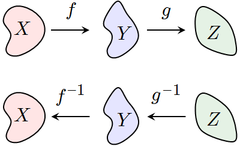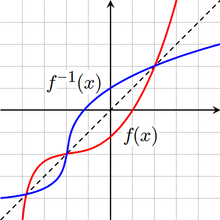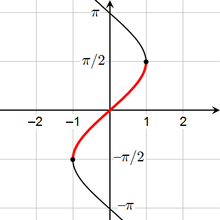
Inverse function
About this schools Wikipedia selection
SOS Children produced this website for schools as well as this video website about Africa. Child sponsorship helps children one by one http://www.sponsor-a-child.org.uk/.
In mathematics, an inverse function is a function that undoes another function: If an input x into the function f produces an output y, then putting y into the inverse function g produces the output x, and vice versa. i.e., f(x)=y, and g(y)=x. More directly, g(f(x))=x, meaning g(x) composed with f(x) leaves x unchanged.
A function f that has an inverse is called invertible; the inverse function is then uniquely determined by f and is denoted by f−1 (read f inverse, not to be confused with exponentiation).
Definitions
The word inverse is related to the word invert meaning to reverse, turn upside down, to do the opposite.
| Look up inverse in Wiktionary, the free dictionary. |
Instead of considering the inverses for individual inputs and outputs, one can think of the function as sending the whole set of inputs, the domain, to a set of outputs, the range. Let f be a function whose domain is the set X, and whose range is the set Y. Then f is invertible if there exists a function g with domain Y and range X, with the property:
If f is invertible, the function g is unique; in other words, there is exactly one function g satisfying this property (no more, no less). That function g is then called the inverse of f, and usually denoted as f−1.
Stated otherwise, a function is invertible if and only if its inverse relation is a function on the range Y, in which case the inverse relation is the inverse function.
Not all functions have an inverse. For this rule to be applicable, each element y ∈ Y must correspond to no more than one x ∈ X; a function f with this property is called one-to-one, or information-preserving, or an injection.
Example: inverse operations that lead to inverse functions
Inverse operations are the opposite of direct variation functions. Direct variation function are based on multiplication; y = kx. The opposite operation of multiplication is division and an inverse variation function is y = k/x.
Example: squaring and square root functions
The function f(x) = x2 may or may not be invertible, depending on the domain.
If the domain is the real numbers, then each element in Y would correspond to two different elements in X (±x), and therefore f would not be invertible. More precisely, the square of x is not invertible because it is impossible to deduce from its output the sign of its input. Such a function is called non- injective or information-losing. Notice that neither the square root nor the principal square root function is the inverse of x2 because the first is not single-valued, and the second returns -x when x is negative.
If the domain consists of the non-negative numbers, then the function is injective and invertible.
Inverses in higher mathematics
The definition given above is commonly adopted in set theory and calculus. In higher mathematics, the notation
means "f is a function mapping elements of a set X to elements of a set Y". The source, X, is called the domain of f, and the target, Y, is called the codomain. The codomain contains the range of f as a subset, and is considered part of the definition of f.
When using codomains, the inverse of a function f: X → Y is required to have domain Y and codomain X. For the inverse to be defined on all of Y, every element of Y must lie in the range of the function f. A function with this property is called onto or a surjection. Thus, a function with a codomain is invertible if and only if it is both injective (one-to-one) and surjective (onto). Such a function is called a one-to-one correspondence or a bijection, and has the property that every element y ∈ Y corresponds to exactly one element x ∈ X.
Inverses and composition
If f is an invertible function with domain X and range Y, then
This statement is equivalent to the first of the above-given definitions of the inverse, and it becomes equivalent to the second definition if Y coincides with the codomain of f. Using the composition of functions we can rewrite this statement as follows:
where idX is the identity function on the set X; that is, the function that leaves X unchanged. In category theory, this statement is used as the definition of an inverse morphism.
If we think of composition as a kind of multiplication of functions, this identity says that the inverse of a function is analogous to a multiplicative inverse. This explains the origin of the notation f−1.
Note on notation
The superscript notation for inverses can sometimes be confused with other uses of superscripts, especially when dealing with trigonometric and hyperbolic functions. To avoid this confusion, the notations f[–1] or with the "-1" above the f are sometimes used.
It is important to realize that f−1(x) is not the same as f(x)−1. In f−1(x), the superscript "−1" is not an exponent. A similar notation is used for iterated functions. For example, f2 denotes two iterations of the function f; if f(x) = x2 − 1, then f2(x) = f(f(x)) = f(x2 − 1) = (x2 − 1)2 − 1, which simplifies to x4 − 2x2. In symbols:
In calculus, f(n), with parentheses, denotes the nth derivative of a function f. For instance:
In trigonometry, for historical reasons, sin2 x usually does mean the square of sin x:
However, the expression sin−1 x usually does not represent the multiplicative inverse to sin x, but the inverse of the sine function applied to x (actually a partial inverse; see below). To avoid confusion, an inverse trigonometric function is often indicated by the prefix "arc". For instance, the inverse of the sine function is typically called the arcsine function, written as arcsin, which is, like sin, conventionally denoted in roman type and not in italics (note that software libraries of mathematical functions often use the name asin):
The function (sin x)–1 is the multiplicative inverse to the sine, and is called the cosecant. It is usually denoted csc x:
Hyperbolic functions behave similarly, using the prefix "ar", as in arsinh for the inverse function of sinh, and csch x for the multiplicative inverse of sinh x.
Properties
Uniqueness
If an inverse function exists for a given function f, it is unique: it must be the inverse relation.
Symmetry
There is a symmetry between a function and its inverse. Specifically, if f is an invertible function with domain X and range Y, then its inverse f−1 has domain Y and range X, and the inverse of f−1 is the original function f. In symbols, for f a function with domain X and range Y, and g a function with domain Y and range X:
This follows from the connection between function inverse and relation inverse, because inversion of relations is an involution.
This statement is an obvious consequence of the deduction that for f to be invertible it must be injective (first definition of the inverse) or bijective (second definition). The property of symmetry can be concisely expressed by the following formula:
The inverse of a composition of functions is given by the formula
Notice that the order of g and f have been reversed; to undo f followed by g, we must first undo g and then undo f.
For example, let f(x) = 3x and let g(x) = x + 5. Then the composition g o f is the function that first multiplies by three and then adds five:
To reverse this process, we must first subtract five, and then divide by three:
This is the composition (f–1 o g–1) (y).
Self-inverses
If X is a set, then the identity function on X is its own inverse:
More generally, a function f: X → X is equal to its own inverse if and only if the composition f o f is equal to idX. Such a function is called an involution.
Inverses in calculus
Single-variable calculus is primarily concerned with functions that map real numbers to real numbers. Such functions are often defined through formulas, such as:
A function f from the real numbers to the real numbers possesses an inverse as long as it is one-to-one, i.e. as long as the graph of y = f(x) has, for each possible y value only one corresponding x value, and thus passes the horizontal line test.
The following table shows several standard functions and their inverses:
-
Function f(x) Inverse f−1(y) Notes x + a y – a a – x a – y mx y / m m ≠ 0 1 / x 1 / y x, y ≠ 0 x2 
x, y ≥ 0 only x3 ![\sqrt[3]{y}](../../images/2472/247204.png)
no restriction on x and y xp y1/p (i.e. ![\sqrt[p]{y}](../../images/2472/247205.png) )
)x, y ≥ 0 in general, p ≠ 0 ex ln y y > 0 ax loga y y > 0 and a > 0 trigonometric functions inverse trigonometric functions various restrictions (see table below)
Formula for the inverse
One approach to finding a formula for f−1, if it exists, is to solve the equation y = f(x) for x. For example, if f is the function
then we must solve the equation y = (2x + 8)3 for x:
Thus the inverse function f−1 is given by the formula
Sometimes the inverse of a function cannot be expressed by a formula with a finite number of terms. For example, if f is the function
then f is one-to-one, and therefore possesses an inverse function f−1. The formula for this inverse has an infinite number of terms:
Graph of the inverse
If f and f−1 are inverses, then the graph of the function
is the same as the graph of the equation
This is identical to the equation y = f(x) that defines the graph of f, except that the roles of x and y have been reversed. Thus the graph of f−1 can be obtained from the graph of f by switching the positions of the x and y axes. This is equivalent to reflecting the graph across the line y = x.
Inverses and derivatives
A continuous function f is one-to-one (and hence invertible) if and only if it is either strictly increasing or decreasing (with no local maxima or minima). For example, the function
is invertible, since the derivative f′(x) = 3x2 + 1 is always positive.
If the function f is differentiable, then the inverse f−1 will be differentiable as long as f′(x) ≠ 0. The derivative of the inverse is given by the inverse function theorem:
If we set x = f–1(y), then the formula above can be written
This result follows from the chain rule (see the article on inverse functions and differentiation).
The inverse function theorem can be generalized to functions of several variables. Specifically, a differentiable function f: Rn → Rn is invertible in a neighbourhood of a point p as long as the Jacobian matrix of f at p is invertible. In this case, the Jacobian of f−1 at f(p) is the matrix inverse of the Jacobian of f at p.
Real-world examples
For example, let f be the function that converts a temperature in degrees Celsius to a temperature in degrees Fahrenheit:
then its inverse function converts degrees Fahrenheit to degrees Celsius:
since
Or, suppose f assigns each child in a family its birth year. An inverse function would output which child was born in a given year. However, if the family has twins (or triplets) then the output cannot be known when the input is the common birth year. As well, if a year is given in which no child was born then a child cannot be named. But if each child was born in a separate year, and if we restrict attention to the three years in which a child was born, then we do have an inverse function. For example,
Generalizations
Partial inverses
Even if a function f is not one-to-one, it may be possible to define a partial inverse of f by restricting the domain. For example, the function
is not one-to-one, since x2 = (–x)2. However, the function becomes one-to-one if we restrict to the domain x ≥ 0, in which case
(If we instead restrict to the domain x ≤ 0, then the inverse is the negative of the square root of y.) Alternatively, there is no need to restrict the domain if we are content with the inverse being a multivalued function:
Sometimes this multivalued inverse is called the full inverse of f, and the portions (such as √x and −√x) are called branches. The most important branch of a multivalued function (e.g. the positive square root) is called the principal branch, and its value at y is called the principal value of f−1(y).
For a continuous function on the real line, one branch is required between each pair of local extrema. For example, the inverse of a cubic function with a local maximum and a local minimum has three branches (see the picture to the right).
These considerations are particularly important for defining the inverses of trigonometric functions. For example, the sine function is not one-to-one, since
for every real x (and more generally sin(x + 2πn) = sin(x) for every integer n). However, the sine is one-to-one on the interval [–π⁄2, π⁄2], and the corresponding partial inverse is called the arcsine. This is considered the principal branch of the inverse sine, so the principal value of the inverse sine is always between –π⁄2 and π⁄2. The following table describes the principal branch of each inverse trigonometric function:
-
function Range of usual principal value sin−1 –π⁄2 ≤ sin−1(x) ≤ π⁄2 cos−1 0 ≤ cos−1(x) ≤ π tan−1 –π⁄2 < tan−1(x) < π⁄2 cot−1 0 < cot−1(x) < π sec−1 0 ≤ sec−1(x) ≤ π csc−1 −π⁄2 ≤ csc−1(x) ≤ π⁄2
Left and right inverses
If f: X → Y, a left inverse for f (or retraction of f) is a function g: Y → X such that
That is, the function g satisfies the rule
Thus, g must equal the inverse of f on the range of f, but may take any values for elements of Y not in the range. A function f with a left inverse is necessarily injective. In classical mathematics, every injective function f necessarily has a left inverse; however, this may fail in constructive mathematics. For instance, a left inverse of the inclusion {0,1} → R of the two-element set in the reals violates indecomposability by giving a retraction of the real line to the set {0,1}.
A right inverse for f (or section of f) is a function h: Y → X such that
That is, the function h satisfies the rule
Thus, h(y) may be any of the elements of X that map to y under f. A function f has a right inverse if and only if it is surjective (though constructing such an inverse in general requires the axiom of choice).
An inverse which is both a left and right inverse must be unique. Likewise, if g is a left inverse for f, then g may or may not be a right inverse for f; and if g is a right inverse for f, then g is not necessarily a left inverse for f. For example let f:R→[0,∞) denote the squaring map, such that f(x)=x2 for all x in R, and let g:[0,∞)→R denote the square root map, such that g(x)=√x for all x≥0. Then f(g(x))=x for all x in [0,∞); that is, g is a right inverse to f. However, g is not a left inverse to f, since, e.g., g(f(-1))=1≠-1.
Preimages
If f: X → Y is any function (not necessarily invertible), the preimage (or inverse image) of an element y ∈ Y is the set of all elements of X that map to y:
The preimage of y can be thought of as the image of y under the (multivalued) full inverse of the function f.
Similarly, if S is any subset of Y, the preimage of S is the set of all elements of X that map to S:
For example, take a function f: R → R, where f: x ↦ x2. This function is not invertible for reasons discussed above. Yet preimages may be defined for subsets of the codomain:
The preimage of a single element y ∈ Y – a singleton set {y} – is sometimes called the fibre of y. When Y is the set of real numbers, it is common to refer to f−1(y) as a level set.




















![\begin{align}
y & = (2x+8)^3 \\
\sqrt[3]{y} & = 2x + 8 \\
\sqrt[3]{y} - 8 & = 2x \\
\dfrac{\sqrt[3]{y} - 8}{2} & = x .
\end{align}](../../images/2472/247207.png)
![f^{-1}(y) = \dfrac{\sqrt[3]{y} - 8}{2} . \,\!](../../images/2472/247208.png)

![f^{-1}(y) =
\displaystyle \sum_{n=1}^{\infty}
{\frac{y^{\frac{n}{3}}}{n!}} \lim_{ \theta \to 0} \left(
\frac{\mathrm{d}^{\,n-1}}{\mathrm{d} \theta^{\,n-1}} \left(
\frac{ \theta }{ \sqrt[3]{ \theta - \sin( \theta )} } ^n \right)
\right)](../../images/2472/247210.png)
























